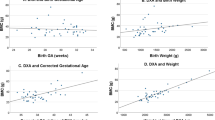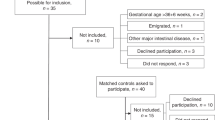Abstract
Objective:
As 80% of intrauterine bone mineralization takes place during the last trimester of pregnancy, preterm infants should be supplemented postnatally with optimal doses of calcium, phosphate and vitamin D. Calcium and phosphate excretion in the urine may be used to monitor individual mineral requirements, but are sometimes difficult to interpret. The objective of this study was to assess the value of quantitative ultrasound (QUS) for the analysis of bone status in neonates.
Study Design:
All admissions to three independent tertiary neonatal intensive care units were studied. In 172 preterm and term infants with a gestational age between 23 and 42 weeks (mean 33.8±5.0) and a birth weight from 405 to 5130 g (mean 2132±1091 g) bone status was evaluated prospectively by quantitative ultrasound velocity using a standardized protocol. Infants were followed in regular intervals up to their first discharge home. While measurements were conducted in weekly intervals initially (n=55), 2-week intervals were regarded as sufficient thereafter due to limited changes in QUS values within the shorter period. Infants with a birth weight below 1500 g were followed during outpatient visits until up to 17 months of age.
Result:
The intra-individual day-to-day reproducibility was 0.62%. QUS-values from the first week of life correlated significantly with gestational age and birth weight (r=0.5 and r=0.6; P<0.001). Small-for-gestational-age infants showed lower values for QUS than appropriate-for-gestational-age infants allowing for their gestational age. Follow-up measurements correlated positively with age and weight during the week of measurement (r=0.2 and r=0.4; P=0.001). Comparing bone quality at 40 weeks of age in infants born at term versus infants born at 24 to 28 weeks, preterm infants showed significantly lower QUS than term infants (P<.0001).There was a significant correlation of QUS with serum alkaline phosphatase (P=0.003), the supplementation with calcium, phosphate and vitamin D (P< 0.001 each), as well as risk factors for a reduced bone mineralization. No correlation was found between QUS and calcium or phosphate concentration in serum or urine.
Conclusion:
QUS is a highly reproducible, easily applicable and radiation-free technique that can be used to monitor bone quality in individual newborns. Further prospective randomized-trials are necessary to evaluate, if therapeutic interventions based on QUS are able to prevent osteopenia of prematurity.
This is a preview of subscription content, access via your institution
Access options
Subscribe to this journal
Receive 12 print issues and online access
$259.00 per year
only $21.58 per issue
Buy this article
- Purchase on Springer Link
- Instant access to full article PDF
Prices may be subject to local taxes which are calculated during checkout



Similar content being viewed by others
References
Rauch F, Schoenau E . Skeletal development in premature infants: a review of bone physiology beyond nutritional aspects. Arch Dis Child Fetal Neonatal Ed 2002; 86: F82–F85.
Sargent JD, Stukel TA, Kresel J, Klein RZ . Normal values for random urinary calcium to creatinine ratios in infancy. J Pediatr 1993; 123: 393–397.
Tsang RC . Nutritional needs of the preterm infant: scientific basis and practical guidelines. 2nd edition. Digital Education Publishing, Inc.: Cincinnati, OH, 2005.
Gilsanz V . Bone density in children: a review of the available techniques and indications. Eur J Radiol 1998; 26: 177–182.
Bouxsein ML, Radloff SE . Quantitative ultrasound of the calcaneus reflects the mechanical properties of calcaneal trabecular bone. J Bone Miner Res 1997; 12: 839–846.
Fricke O, Tutlewski B, Schwahn B, Schoenau E . Speed of sound: relation to geometric characteristics of bone in children, adolescents, and adults. J Pediatr 2005; 146: 764–768.
Sakata S, Barkmann R, Lochmuller EM, Heller M, Gluer CC . Assessing bone status beyond BMD: evaluation of bone geometry and porosity by quantitative ultrasound of human finger phalanges. J Bone Miner Res 2004; 19: 924–930.
Gluer CC, Eastell R, Reid DM, Felsenberg D, Roux C, Barkmann R et al. Association of five quantitative ultrasound devices and bone densitometry with osteoporotic vertebral fractures in a population-based sample: the OPUS Study. J Bone Miner Res 2004; 19: 782–793.
Rubinacci A, Moro GE, Boehm G, de Terlizzi F, Moro GL, Cadossi R . Quantitative ultrasound for the assessment of osteopenia in preterm infants. Eur J Endocrinol 2003; 149: 307–315.
Ritschl E, Wehmeijer K, de Terlizzi F, Wipfler E, Cadossi R, Douma D et al. Assessment of skeletal development in preterm and term infants by quantitative ultrasound. Pediatr Res 2005; 58: 341–346.
Pereda L, Ashmeade T, Zaritt J, Carver JD . The use of quantitative ultrasound in assessing bone status in newborn preterm infants. J Perinatol 2003; 23: 655–659.
Litmanovitz I, Dolfin T, Friedland O, Arnon S, Regev R, Shainkin-Kestenbaum R et al. Early physical activity intervention prevents decrease of bone strength in very low birth weight infants. Pediatrics 2003; 112: 15–19.
Gonnelli S, Montagnani A, Gennari L, Martini S, Merlotti D, Cepollaro C et al. Feasibility of quantitative ultrasound measurements on the humerus of newborn infants for the assessment of the skeletal status. Osteoporos Int 2004; 15: 541–546.
Nemet D, Dolfin T, Wolach B, Eliakim A . Quantitative ultrasound measurements of bone speed of sound in premature infants. Eur J Pediatr 2001; 160: 736–740.
Tomlinson C, McDevitt H, Ahmed SF, White MP . Longitudinal changes in bone health as assessed by the speed of sound in very low birth weight preterm infants. J Pediatr 2006; 148: 450–455.
McDevitt H, Tomlinson C, White MP, Ahmed SF . Quantitative ultrasound assessment of bone in preterm and term neonates. Arch Dis Child Fetal Neonatal Ed 2005; 90: F341–F342.
Littner Y, Mandel D, Mimouni FB, Dollberg S . Bone ultrasound velocity of infants born small for gestational age. J Pediatr Endocrinol Metab 2005; 18: 793–797.
Specker BL, Beck A, Kalkwarf H, Ho M . Randomized trial of varying mineral intake on total body bone mineral accretion during the first year of life. Pediatrics 1997; 99: E12.
Bauer DC, Gluer CC, Cauley JA, Vogt TM, Ensrud KE, Genant HK et al. Broadband ultrasound attenuation predicts fractures strongly and independently of densitometry in older women. A prospective study. Study of Osteoporotic Fractures Research Group. Arch Intern Med 1997; 157: 629–634.
Schonau E, Radermacher A, Wentzlik U, Klein K, Michalk D . The determination of ultrasound velocity in the os calcis, thumb and patella during childhood. Eur J Pediatr 1994; 153: 252–256.
Shaw JC . Evidence for defective skeletal mineralization in low-birthweight infants: the absorption of calcium and fat. Pediatrics 1976; 57: 16–25.
Wright LL, Glade MJ, Gopal J . The use of transmission ultrasonics to assess bone status in the human newborn. Pediatr Res 1987; 22: 541–544.
Koo WW, Walters J, Bush AJ, Chesney RW, Carlson SE . Dual-energy X-ray absorptiometry studies of bone mineral status in newborn infants. J Bone Miner Res 1996; 11: 997–102.
Salle BL, Braillon P, Glorieux FH, Brunet J, Cavero E, Meunier PJ . Lumbar bone mineral content measured by dual energy X-ray absorptiometry in newborns and infants. Acta Paediatr 1992; 81: 953–958.
Avila-Diaz M, Flores-Huerta S, Martinez-Muniz I, Amato D . Increments in whole body bone mineral content associated with weight and length in pre-term and full-term infants during the first 6 months of life. Arch Med Res 2001; 32: 288–292.
Chan GM, Armstrong C, Moyer-Mileur L, Hoff C . Growth and bone mineralization in children born prematurely. J Perinatol 2008; 28: 619–623.
Littner Y, Mandel D, Mimouni FB, Dollberg S . Decreased bone ultrasound velocity in large-for-gestational-age infants. J Perinatol 2004; 24: 21–23.
Littner Y, Mandel D, Mimouni FB, Dollberg S . Bone ultrasound velocity curves of newly born term and preterm infants. J Pediatr Endocrinol Metab 2003; 16: 43–47.
Zadik Z, Price D, Diamond G . Pediatric reference curves for multi-site quantitative ultrasound and its modulators. Osteoporos Int 2003; 14: 857–862.
Sundberg M, Gardsell P, Johnell O, Ornstein E, Sernbo I . Comparison of quantitative ultrasound measurements in calcaneus with DXA and SXA at other skeletal sites: a population-based study on 280 children aged 11 to 16 years. Osteoporos Int 1998; 8: 410–417.
Baroncelli GI, Federico G, Bertelloni S, de Terlizzi F, Cadossi R, Saggese G . Bone quality assessment by quantitative ultrasound of proximal phalanxes of the hand in healthy subjects aged 3--21 years. Pediatr Res 2001; 49: 713–718.
Lequin MH, van Rijn RR, Robben SG, Hop WC, van Kuijk C . Normal values for tibial quantitative ultrasonometry in caucasian children and adolescents (aged 6 to 19 years). Calcif Tissue Int 2000; 67: 101–105.
Minton SD, Steichen JJ, Tsang RC . Bone mineral content in term and preterm appropriate-for-gestational-age infants. J Pediatr 1979; 95: 1037–1042.
Mercy J, Dillon B, Morris J, Emmerson AJ, Mughal MZ . Relationship of tibial speed of sound and lower limb length to nutrient intake in preterm infants. Arch Dis Child Fetal Neonatal Ed 2007; 92: F381–F385.
Ahmad I, Nemet D, Eliakim A, Koeppel R, Grochow D, Coussens M et al. Body composition and its components in preterm and term newborns: a cross-sectional, multimodal investigation. Am J Hum Biol 2010; 22: 69–75.
Namgung R, Tsang RC, Sierra RI, Ho ML . Normal serum indices of bone collagen biosynthesis and degradation in small for gestational age infants. J Pediatr Gastroenterol Nutr 1996; 23: 224–228.
Namgung R, Tsang RC . Factors affecting newborn bone mineral content: in utero effects on newborn bone mineralization. Proc Nutr Soc 2000; 59: 55–63.
Beltrand J, Alison M, Nicolescu R, Verkauskiene R, Deghmoun S, Sibony O et al. Bone mineral content at birth is determined both by birth weight and fetal growth pattern. Pediatr Res 2008; 64: 86–90.
Zanardo V, Dani C, Trevisanuto D, Meneghetti S, Guglielmi A, Zacchello G et al. Methylxanthines increase renal calcium excretion in preterm infants. Biol Neonate 1995; 68: 169–174.
Backstrom MC, Kouri T, Kuusela AL, Sievänen H, Koivisto AM, Ikonen RS et al. Bone isoenzyme of serum alkaline phosphatase and serum inorganic phosphate in metabolic bone disease of prematurity. Acta Paediatr 2000; 89: 867–873.
Altuncu E, Akman I, Yurdakul Z, Ozdoğan T, Solakoğlu M, Selim N et al. Quantitative ultrasound and biochemical parameters for the assessment of osteopenia in preterm infants. J Matern Fetal Neonatal Med 2007; 20: 401–405.
Shrivastava A, Lyon A, Mcintosh N . The effect of dexamethasone on growth, mineral balance and bone mineralisation in preterm infants with chronic lung disease. Eur J Pediatr 2000; 159: 380–384.
Acknowledgements
We are grateful to all infants and their parents who took part in this study, to all nurses and doctors for their assistance, and to Heidi Weitmann Coleman for her editorial support. The prototype Osteoson K IV was kindly provided by Minhorst, Meudt, Germany
Author information
Authors and Affiliations
Corresponding author
Ethics declarations
Competing interests
The authors declare no conflict of interest.
Rights and permissions
About this article
Cite this article
Rack, B., Lochmüller, EM., Janni, W. et al. Ultrasound for the assessment of bone quality in preterm and term infants. J Perinatol 32, 218–226 (2012). https://doi.org/10.1038/jp.2011.82
Received:
Revised:
Accepted:
Published:
Issue Date:
DOI: https://doi.org/10.1038/jp.2011.82
Keywords
This article is cited by
-
Tibial quantitative ultrasound compared to dual-energy X-ray absorptiometry in preterm infants
Journal of Perinatology (2023)
-
Effect of physiotherapy on the promotion of bone mineralization in preterm infants: a randomized controlled trial
Scientific Reports (2022)
-
Is quantitative ultrasound a measure for metabolic bone disease in preterm-born infants? A prospective subcohort study
European Journal of Pediatrics (2021)
-
Feasibility of quantitative ultrasonography for the detection of metabolic bone disease in preterm infants — systematic review
Pediatric Radiology (2018)
-
MOnitored supplementation of VItamin D in preterm infants (MOSVID trial): study protocol for a randomised controlled trial
Trials (2017)



